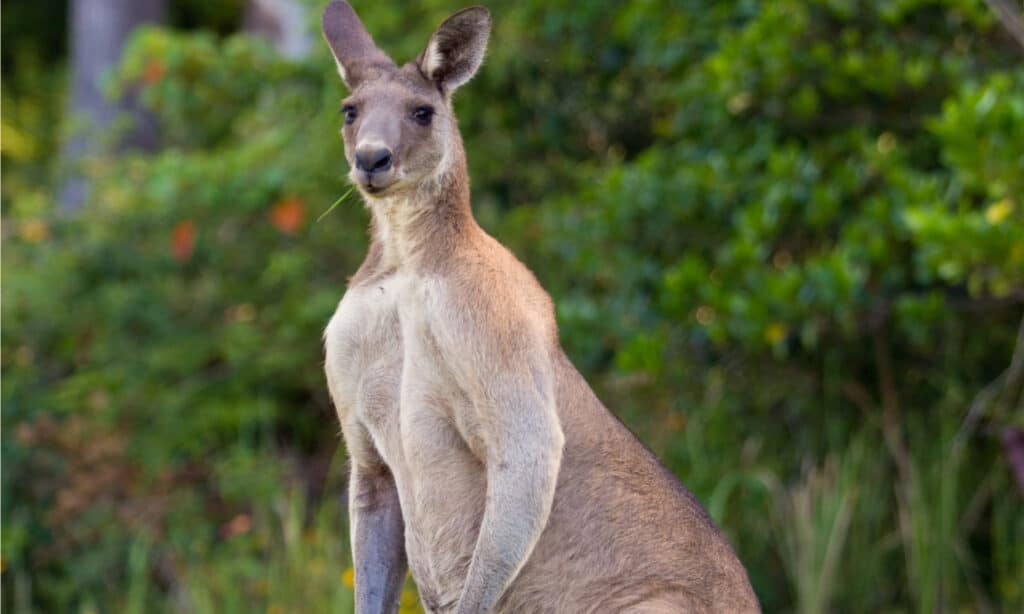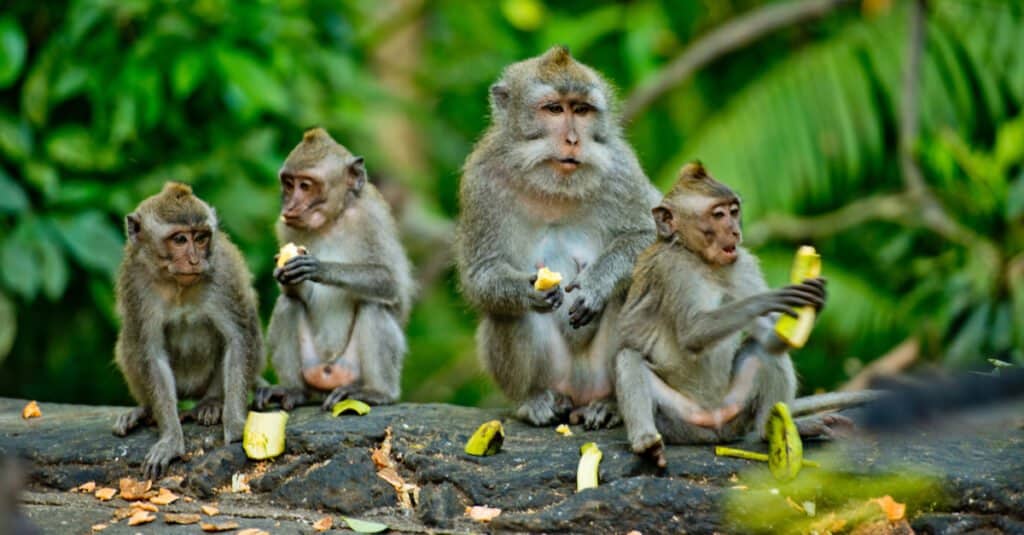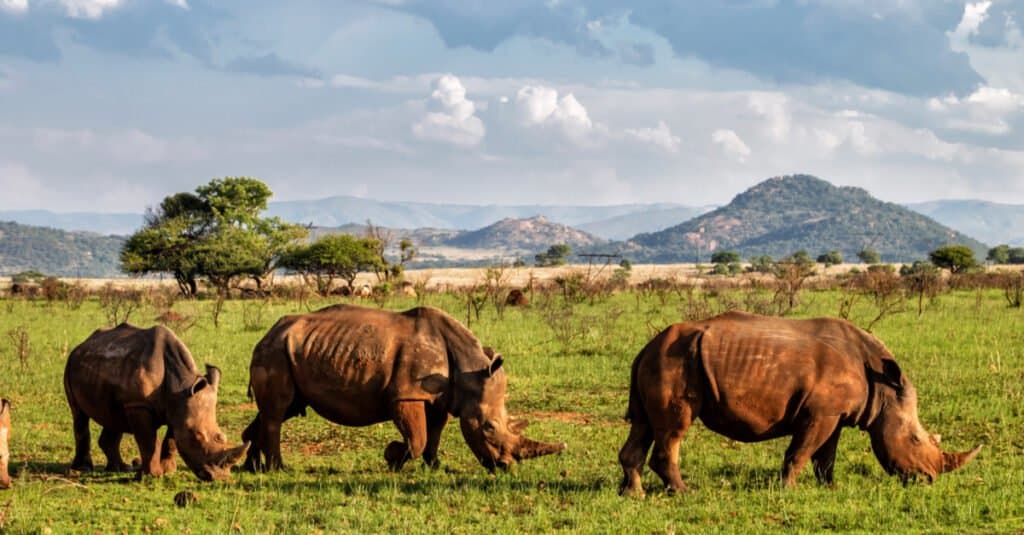Have you herd? Names groups of various animals often have unique and sometimes funny names. You’re probably familiar with common farm and backyard animals – flocks of birds and herds of cows or sheep. These terms often encompass the animals listed below. But there are so many more names of animal groups to discover!
Why are names of animal groups often so weird or funny? One reason is that many of these collective animal group names originated in medieval times, especially the English hunting tradition. We’ll discuss the origin of each funny name for animal groups when it is known.
Many of the weird collective nouns for names for groups of animals are no longer used, but it is fun and informative to learn about them. We’ve arranged our list in alphabetical order based on the common name of the animal.
Apes: A Shrewdness of Apes
In other contexts, shrewdness refers to the ability to choose the best course of action.
Badgers: A Cete of Badgers
The word cete may be a variant of “cite,” meaning “town,” from which the word “city” was also derived.
Bats: A Colony, Cloud, Cauldron or Camp of Bats
When in flight, a large group of bats does resemble a dark cloud. Our favorite is “cauldron,” reminiscent of the “creepy” stereotypes bats are often afforded.

Their animal group goes by many different names, but bats travel in a colony, cloud, cauldron or camp.
©Photoongraphy/Shutterstock.com
Bears: A Sloth or Sleuth of Bears
Sloth is an old word for laziness. “Sleuth” originally referred to the bloodhound.
Bees: A Swarm of Bees
This term is still a familiar name for a group of animals and in common use today.
Bittern: A Sedge of Bitterns
A bittern is a small bird in the heron family, and sedges are the marsh grasses in which it hunts.
Buffalo: A Gang or Obstinancy of Buffalo
When a herd of buffalo crosses the road in one of North America‘s national parks, they take their time, undeterred by cars with honking horns. This makes “obstinancy,” meaning stubbornness, a fitting term.
Buzzard: A Wake of Buzzards
A wake is a funeral tradition in which friends and family members stay up all night to watch over the body. Vultures are also known for their attraction to corpses.
Bobolink: A Chain of Bobolinks
The bobolink is a small North American songbird. Its name is an onomatopoeia of its call, and its collective noun might be a play on the “link” in its name.
Camels: A Caravan of Camels
These sturdy mammals often served as pack animals in desert caravans.
Cats: A Clowder, Pounce or Glaring of Cats
The above aren’t the only collective names for cats. Kittens are referred to as a litter or kindle, or you might spy a destruction of wild cats.
Cobras: A Quiver of Cobras
The origin of the word quiver refers to a pouch used to carry arrows for hunting or warfare.
Crocodiles: A Bask of Crocodiles
Perhaps so named due to the crocodiles‘ habit of basking in the sun on riverbanks.
Crows: A Murder or Horde of Crows
The term “murder” was a poetic term used in fifteenth-century English literature. Some superstitions held that crows are good or bad omens.
Dogs: A Pack of Dogs
The origin of “pack” means a group of things tied together. Puppies are referred to as a litter. “A cowardice of curs” means a pack of aggressive wild or feral dogs.

Whether you’re referring to wild dogs, wolves, or your domesticated pups at home, a group of dogs is called a pack.
©Marjolein Hameleers/Shutterstock.com
Donkeys: A Drove or Pace of Donkeys
Perhaps related to “driving” the animals for farm work and the slow, steady pace they keep.
Eagles: A Convocation of Eagles
Convocation refers to “a group of people gathered in answer to a summons,” especially in a religious setting.
Elephants: A Herd or Parade of Elephants

A group of
elephants
is referred to as a herd
©ElephantErik/Shutterstock.com
A fitting description of these large animals!
Elk: A Gang or a Herd of Elk
“Gang” once meant “a manner of going.”
Falcons: A Cast of Falcons
The sport of falconry has been practiced for at least 2,000 years.
Ferrets: A Business of Ferrets
These silly animals are all funny business!
Fish: A School of Fish
Derived from the Middle Dutch term “schole,” from which the English “shoal” is also derived.
Flamingos: A Stand or Flamboyance of Flamingos
A fitting term for these brightly-hued birds.
Foxes: A Skulk, Earth, or Leash of Foxes
To “skulk” means to sneak around, something that foxes are very good at.
Frogs: An Army or Knot of Frogs or Toads
A humorous title for these harmless creatures.
Geese: A Gaggle or Skein of Geese
It’s a gaggle on the ground and a skein in flight.
Giraffes: A Tower of Giraffes
Fitting for the tallest land animal.

A tower of grazing giraffes can eat hundreds of pounds of leaves per week, reaching their long necks to forage leaves, seeds, fruit, buds, and tree branches.
©rudiPro/Shutterstock.com
Goats: A Tribe or Trip of Goats
“Trip” may originate from the folktale Three Billy Goats Gruff, or from a Middle Dutch word meaning skip or hop.
Gorillas: A Band of Gorillas
Origins can be traced to military terms.
Hippopotamus: A Bloat or Thunder of Hippopotami
Both terms depict the animals’ great size.
Hyenas: A Cackle of Hyenas
Refers to this animal’s famous laugh-like vocalization
Jaguars: A Shadow of Jaguars
No doubt referring to the animals’ unique camouflage.
Jellyfish: A Smack of Jellyfish
A keen description of what it feels like when you swim into a group of these stinging creatures!
Kangaroos: A Troop or Mob of Kangaroos
Both terms have been used to refer to groups of humans acting with purpose.

Kangaroo
©kimonofish/Shutterstock.com
Lemurs: A Conspiracy of Lemurs
This weird term means “to plot or plan in secret” in other contexts.
Leopards: A Leap of Leopards
No doubt derived from the leopard’s common name.
Lions: A Pride or Sawt of Lions
Sawt may derive from an Arabic term meaning “voice.”
Martins: A Richness of Martins
Similar to the ermine and mink, martins were once hunted for their fur.
Mice: A Mischief of Mice
We reckon mice earned this moniker, referring to their playful ways.
Moles: A Labor of Moles
Digging those tunnels is a lot of labor or work, both for the mole and for the gardener!
Monkeys: A Barrel or Troop of Monkeys
The term “barrel” was first recorded in the 1800s and inspired the classic children’s toy.

A troop works together to take care of the group’s young monkeys, playing, cuddling, and protecting. The troop’s leader is the strongest and largest of the male monkeys.
©Leo_nik/Shutterstock.com
Mules: A Pack, Span, or Barren of Mules
A “span” is typically two mules, used to pull a wagon or plow.
Otters: A Family or Romp of Otters
To “romp” means to frolic, which describes the otters‘ energetic movements.
Oxen: A Team or Yoke of Oxen
The yoke is a wooden bar that links two animals together to pull a wagon or a plow.
Owls: A Parliament of Owls
The term refers to a gathering to discuss important matters. Likely linked to the owls ‘ longstanding stereotype of being wise.
Parrots: A Pandemonium of Parrots
Alliteration as well as a description of the chaotic squawking of a large group of these birds.
Pigs: A Drift, Drove, Sounder, Team, or Passel of Pigs
Drift and drove typically refer to young pigs, while team and sounder are used for older animals.
Porcupines: A Prickle of Porcupines
A cute reference to the animals’ quills.
Porpoises: A Pod, School, Herd, or Turmoil of Porpoises
“Turmoil” refers to the underwater commotion that may be caused by these small whales.
Rabbits: a herd, Colony, Warren, Nest, Down, or Husk
Only domesticated rabbits are referred to as a herd.
Rats: A Colony of Rats
Rats stowed away on ships to colonize many islands.
Ravens: An Unkindness of Ravens
May refer to ravens’ mythical reputation as tricksters or the false view that they are bad parents.
Rhinoceros: A Crash of Rhinoceroses
“Crash” is the sound made by a charging group!

Rhinos gather on the plains in groups called a “crash.”
©Henk Bogaard/Shutterstock.com
Shark: A Shiver of Sharks
This could refer to the fear sharks cause or the fact that they are cold-blooded.
Skunk: A Stench of Skunks
This refers to this mammals’ ability to spray odorous liquid in self-defense.
Snakes: A Nest of Snakes
Not only do snakes hatch from a nest, but some species gather by the hundreds to overwinter in burrows.
Squirrels: A Dray or Scurry of Squirrels
“Scurry” describes the animals’ method of movement.
Stingrays: A Fever of Stingrays
Groups can reach up to 10,000 individuals.
Swans: A Bevy, Game, or Wedge of Swans
“Wedge” describes the pattern the birds take in flight.
Tigers: an Ambush or Streak of Tigers
Describes the animals’ motion and hunting style.
Whales: A Pod, School, Herd, or Gam
“Gam” once referred to an attractive female leg.
Wolves: A Pack, Rout, or Route
The term route is typically only used when the pack is on the move.
Zebras: A Zeal
You have to admire the alliteration used here.

Zebra stripes are as unique as fingerprints and help the zeal to camouflage.
©iStock.com/Cavan Images
The photo featured at the top of this post is © iStock.com/Cavan Images
Thank you for reading! Have some feedback for us? Contact the AZ Animals editorial team.






